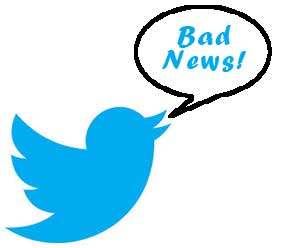
Put Twitter in your crisis communications plan.
Dear Mr. Communicator: We’re a large nonprofit organization with a crisis communications plan written in the pre-Twitter era. How can we incorporate Twitter into our handling of adverse events? –a cautious PR exec
Dear Cautious:
You have an alert, well-trained staff and a detailed crisis communications plan. Here are some suggested tweaks about tweets.
In the examples below, I’m using ORG and Organization as the hypothetical name of your group.
Preparing to use social media a communications crisis
Ensure that key staff members and your leadership have their own Twitter accounts. These don’t need to be actual personal accounts, but they could have usernames like ORG_communications and ORG_advocacy, etc.
Facebook can be handled differently than Twitter. It may not be appropriate to ask an employee to use her/his Facebook account for your organization’s business; and it may not be practical to set up special Facebook accounts.
Establish which Twitter client is best for live monitoring a developing adverse event and ensure that key staff know how to use it. When searching for the best option, note that Twitter changes its interface often and the Twitter client that worked well last year might not even work at all today.
In a crisis or adverse event
If it’s not already there, put something in your crisis plan about how you will evaluate whether your organization is best served by being highly visible or in response-only mode.
If — according to your monitoring — the event doesn’t yet have a presence on Twitter, there may be no benefit to mentioning it, at least not yet. If and when tweets begin appearing, tweet that you are aware of the situation and handling it according to your organization’s established protocol. (For most companies and nonprofits, it is very important to show that you follow carefully developed procedures.)
Depending on the severity of the adverse event, set up a meeting room with a Twitter feed projected on a large screen for effective, immediate monitoring.
Hashtags in crisis communications
Conduct searches to determine if hashtags are being used by external parties related to the event, and monitor accordingly. In a highly visible, developing event, create your own hashtag that you can use when posting frequent updates.
The media page of your Web site should be the authoritative source for any information coming from your organization. Twitter and Facebook posts should contain links to your site.
When event-related news releases are written, also write a suggested tweet and Facebook post, keeping keywords, hashtags and word length limits in mind.
When releases are posted on your media page (and possibly on the national news release distribution services), ask all relevant staff members to tweet them using the supplied text.
Be sure to monitor tweets from employees, stakeholders, customers and/or members to ensure that they are staying on message.
We can help
Contact Jonathan Lehrer Communications for assistance in thinking through these issues and modifying your plan or running your staff through adverse event drills.
